Demand-pull inflation occurs when the aggregate demand in an economy significantly exceeds aggregate supply, leading to an overall increase in the price level. Here are the key causes that typically lead to this type of inflation:
1. Increased Consumer Spending
When consumers have more disposable income, they tend to increase their spending on goods and services. This rise in consumer spending could be due to higher wages, lower taxes, or increased consumer confidence. If the production capacity does not expand correspondingly, the increased demand leads to higher prices.
2. Government Spending
Fiscal policies involving increased government spending can also trigger demand-pull inflation. When the government spends more on projects, services, or subsidies, it injects additional money into the economy. If this increased spending is not matched by an increase in production, it will lead to higher demand and higher prices.
3. Expansionary Monetary Policies
Central banks may implement expansionary monetary policies, such as lowering interest rates or increasing the money supply through mechanisms like quantitative easing. These policies make borrowing cheaper and increase the amount of money circulating in the economy, boosting spending and investment by businesses and consumers. Again, if supply doesn’t keep up with this increased demand, prices will rise.
4. Increase in Exports
If there is a significant rise in demand for a country’s exports, it can lead to increased production and higher prices domestically. This happens because the domestic market needs to compete with foreign buyers for the same products, pushing up prices.
5. Decrease in Imports
Similarly, if import costs increase due to tariffs, quotas, or depreciations in the domestic currency, consumers and businesses might turn to domestic products instead. This shift can increase domestic demand suddenly, outstripping supply and causing prices to rise.
6. Societal Changes or Trends
Changes in consumer preferences, population growth, or urbanization can also lead to increased demand for certain goods and services. For instance, if there is a growing preference for organic food, the demand for these products may increase rapidly. If the agricultural sector can’t keep up due to limited production capacity or slow supply chain adjustments, prices for these products will inflate.
7. Technological Innovations
Technological advancements can create new products or enhance the desirability of existing ones, suddenly increasing demand. For example, the introduction of a revolutionary new smartphone or electric vehicle can lead to significant consumer interest and demand that outpaces supply capacity, driving up prices.
Real-World Example
A classic example of demand-pull inflation can be observed in the housing market during economic boom periods. As more people find themselves with higher incomes or access to cheaper mortgage rates, the demand for homes increases. However, since new home construction can’t ramp up overnight, the limited housing stock leads to higher home prices and rents.
In sum, demand-pull inflation reflects a vibrant economic activity where consumption desires outstrip productive capacities, leading to rising prices. This type of inflation underscores the delicate balance needed between stimulating economic growth and avoiding excessive inflationary pressures.

